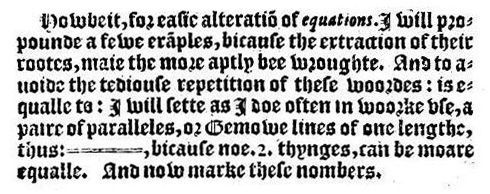The first instance of the concept of a symbolic mathematical equation is usually attributed to Robert Recorde, a Welsh mathematician, in a 1557 book with the rather verbose title ‘The Whetstone of Witte, whiche is the seconde parte of Arithmeteke: containing the extraction of rootes; the cossike practise, with the rule of equation; and the workes of Surde Nombers’.
That is to say, Recorde invented the equals sign, which is still in use today. However, over the centuries it has undergone significant length contraction. As Piers Bursill-Hall remarked (you may enjoy reading his History of Maths lecture notes or, even better, attending the aforementioned lectures), the symbol for equality was a pair of ridiculously elongated parallel lines, like so:
Even though he invented one of the most useful mathematical notations in existence, Recorde had very bizarre reasons for doing so. In The Whetsone of Witte, he explained his reasoning for choosing the symbol to represent equality, namely that ‘no two things can be more equal than a pair of parallel lines’ (!).

Actually, the hyperbolic Fermat equation shown above is not entirely in Recorde’s notation, since the Cartesian notation for powers had not been adopted. Recorde had a brilliantly clumsy method of expressing powers of quantities. We still had the Hindu-Arabic numerals at this point thanks to Fibonacci’s text, Liber Abaci (which Bursill-Hall accidentally spoonerised, resulting in him saying ‘[…] the great mathematician, Liberace’). Hence, Recorde would have expressed the quantities in this equation as:
30042907 square
So far, so good. And you can probably guess the next one:
96222 cube
Again, nothing out of the ordinary. But once we get to higher powers, the notation appears slightly comical:
43 zenzizenzizenzic
What? Zenzizenzizenzic???
I have to admit that this is definitely my favourite obsolete mathematical notation. It is based on a Germanised spelling of the Italian word censo (meaning ‘squared’), and exists in the Oxford English Dictionary, noted for possessing more copies of the letter ‘z’ than any other word. Some books feature 16th powers, described as zenzizenzizenzizenzic (starting to get ridiculous now), but this term unfortunately did not make it into the OED.
The fourth power, of course, was merely denoted zenzizenzic. The fifth power was called the first sursolid, and subsequent prime exponents were described similarly. There’s almost a sub-exponential-time algorithm for converting the Nth power into Recorde’s notation:
- Factorise the number N into a product of primes (with possible multiplicity). This can be done in sub-exponential time using the General Number Field Sieve.
- Sort the prime factors into ascending order. This can be accomplished in O(log N log log N) time with von Neumann’s merge sort.
- If there is only one instance of ‘2’ or ‘3’, replace it with ‘square’ or ‘cube’, respectively. If there is more than one instance, replace each ‘2’ with ‘zenzi’, each ‘3’ with ‘cubi’, and concatenate them with a final ‘c’ appended.
- Replace any remaining primes p with ‘(π(p) − 2)th sursolid’, where π is the prime-counting function. This can be accomplished in time O(p^(½ + ε)) with the Lagarias-Odlyzyko algorithm. Unfortunately, unless N is a smooth number, this final step is exponential in the input length, destroying what would otherwise be a sub-exponential-time algorithm.
Contrast this with linear time for expressing a power in Descartes’ notation, and it is clear that moving away from Recorde’s notation was probably a good idea.

How does one acquire a copy of the History of Maths lecture notes? I feel these could be appropriate entertainment for an early morning ferry trip tomorrow.
Nevermind, I found the link. 😛
Then again, I can’t access the pdf…
Oh, sorry, I think you have to be inside the .cam.ac.uk network. You’ll have to remind me on or after the 6th October, when I regain absolute power. 😛
If you can’t wait that long, you could always pester me on the 5th instead.
Alternatively, I could pester Ben Green… Oh, wait, he’s not at Cambridge. ;P
Being picky here, but these aren’t even lines. These are line segments 😛
I am enjoying thinking of Robert Recorde as reading his equations out loud in the style of legendary boxing announcer Michael Buffer.
“One pluus one equaaaaaaaaaaaaaaaaaaaaaaaaaaaaaaaaaaaals TWO!”